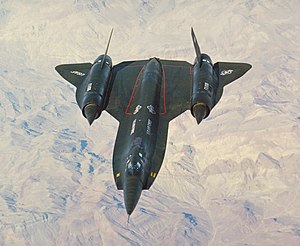| YF-12 | |
|---|---|
 YF-12A | |
| General information | |
| Type | Interceptor aircraft |
| Manufacturer | Lockheed Corporation |
| Status | Canceled |
| Primary users | United States Air Force |
| Number built | 3 |
| History | |
| First flight | 7 August 1963 |
| Developed from | Lockheed A-12 |
The Lockheed YF-12 is an American Mach 3+ capable, high-altitude interceptor prototype, developed and manufactured by American aerospace company Lockheed Corporation.
The interceptor was developed during the late 1950s and early 1960s as a potential replacement for the F-106 Delta Dart interceptor for the United States Air Force (USAF). The YF-12 was a twin-seat version of the then-secret single-seat Lockheed A-12 reconnaissance aircraft operated by the Central Intelligence Agency (CIA); unlike the A-12, it was furnished with the Hughes AN/ASG-18 fire-control radar and could be armed with AIM-47 Falcon (GAR-9) air-to-air missiles. Its maiden flight was on 7 August 1963. Its existence was publicly revealed by President Lyndon B. Johnson on 24 February 1964; this move was to provide plausible deniability for the CIA-operated A-12 fleet, which closely resembled the prototype YF-12.
During the 1960s, the YF-12 underwent flight evaluations by the USAF, but funding to put it into operational use was not forthcoming partly due to the pressing demands of the Vietnam War and other military priorities. It set and held speed and altitude world records of over 2,000 miles per hour (3,200 km/h) and over 80,000 feet (24,000 m) (later surpassed by the closely related SR-71 Blackbird), and is the world's largest, heaviest and fastest crewed interceptor.[1] Following its retirement by the USAF, it served as a research aircraft for NASA for a time, which used it to develop several significant improvements in control for future supersonic aircraft.
- ^ Pace, Steve (1995). X-Planes at Edwards. Zenith Imprint. p. 11. ISBN 978-1-61060786-5.